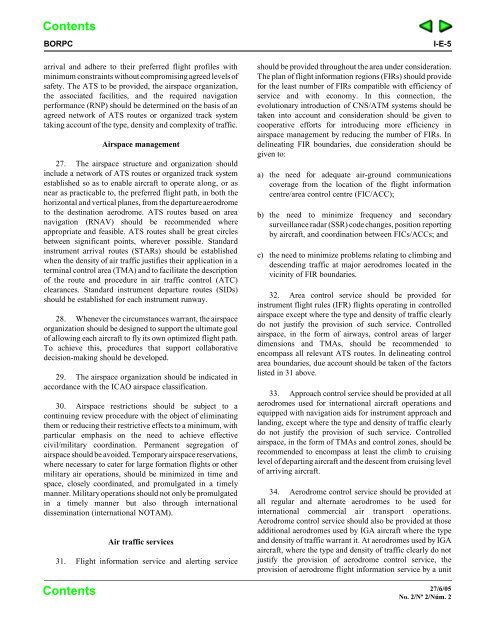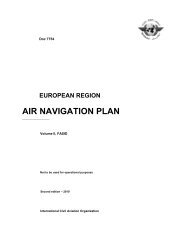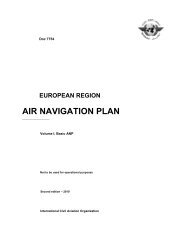introduction - ICAO Public Maps
introduction - ICAO Public Maps
introduction - ICAO Public Maps
Create successful ePaper yourself
Turn your PDF publications into a flip-book with our unique Google optimized e-Paper software.
BORPC<br />
arrival and adhere to their preferred flight profiles with<br />
minimum constraints without compromising agreed levels of<br />
safety. The ATS to be provided, the airspace organization,<br />
the associated facilities, and the required navigation<br />
performance (RNP) should be determined on the basis of an<br />
agreed network of ATS routes or organized track system<br />
taking account of the type, density and complexity of traffic.<br />
Airspace management<br />
27. The airspace structure and organization should<br />
include a network of ATS routes or organized track system<br />
established so as to enable aircraft to operate along, or as<br />
near as practicable to, the preferred flight path, in both the<br />
horizontal and vertical planes, from the departure aerodrome<br />
to the destination aerodrome. ATS routes based on area<br />
navigation (RNAV) should be recommended where<br />
appropriate and feasible. ATS routes shall be great circles<br />
between significant points, wherever possible. Standard<br />
instrument arrival routes (STARs) should be established<br />
when the density of air traffic justifies their application in a<br />
terminal control area (TMA) and to facilitate the description<br />
of the route and procedure in air traffic control (ATC)<br />
clearances. Standard instrument departure routes (SIDs)<br />
should be established for each instrument runway.<br />
28. Whenever the circumstances warrant, the airspace<br />
organization should be designed to support the ultimate goal<br />
of allowing each aircraft to fly its own optimized flight path.<br />
To achieve this, procedures that support collaborative<br />
decision-making should be developed.<br />
29. The airspace organization should be indicated in<br />
accordance with the <strong>ICAO</strong> airspace classification.<br />
30. Airspace restrictions should be subject to a<br />
continuing review procedure with the object of eliminating<br />
them or reducing their restrictive effects to a minimum, with<br />
particular emphasis on the need to achieve effective<br />
civil/military coordination. Permanent segregation of<br />
airspace should be avoided. Temporary airspace reservations,<br />
where necessary to cater for large formation flights or other<br />
military air operations, should be minimized in time and<br />
space, closely coordinated, and promulgated in a timely<br />
manner. Military operations should not only be promulgated<br />
in a timely manner but also through international<br />
dissemination (international NOTAM).<br />
Air traffic services<br />
31. Flight information service and alerting service<br />
I-E-5<br />
should be provided throughout the area under consideration.<br />
The plan of flight information regions (FIRs) should provide<br />
for the least number of FIRs compatible with efficiency of<br />
service and with economy. In this connection, the<br />
evolutionary <strong>introduction</strong> of CNS/ATM systems should be<br />
taken into account and consideration should be given to<br />
cooperative efforts for introducing more efficiency in<br />
airspace management by reducing the number of FIRs. In<br />
delineating FIR boundaries, due consideration should be<br />
given to:<br />
a) the need for adequate air-ground communications<br />
coverage from the location of the flight information<br />
centre/area control centre (FIC/ACC);<br />
b) the need to minimize frequency and secondary<br />
surveillance radar (SSR) code changes, position reporting<br />
by aircraft, and coordination between FICs/ACCs; and<br />
c) the need to minimize problems relating to climbing and<br />
descending traffic at major aerodromes located in the<br />
vicinity of FIR boundaries.<br />
32. Area control service should be provided for<br />
instrument flight rules (IFR) flights operating in controlled<br />
airspace except where the type and density of traffic clearly<br />
do not justify the provision of such service. Controlled<br />
airspace, in the form of airways, control areas of larger<br />
dimensions and TMAs, should be recommended to<br />
encompass all relevant ATS routes. In delineating control<br />
area boundaries, due account should be taken of the factors<br />
listed in 31 above.<br />
33. Approach control service should be provided at all<br />
aerodromes used for international aircraft operations and<br />
equipped with navigation aids for instrument approach and<br />
landing, except where the type and density of traffic clearly<br />
do not justify the provision of such service. Controlled<br />
airspace, in the form of TMAs and control zones, should be<br />
recommended to encompass at least the climb to cruising<br />
level of departing aircraft and the descent from cruising level<br />
of arriving aircraft.<br />
34. Aerodrome control service should be provided at<br />
all regular and alternate aerodromes to be used for<br />
international commercial air transport operations.<br />
Aerodrome control service should also be provided at those<br />
additional aerodromes used by IGA aircraft where the type<br />
and density of traffic warrant it. At aerodromes used by IGA<br />
aircraft, where the type and density of traffic clearly do not<br />
justify the provision of aerodrome control service, the<br />
provision of aerodrome flight information service by a unit<br />
27/6/05<br />
No. 2/Nº 2/Núm. 2














